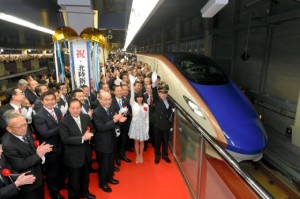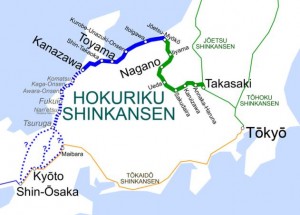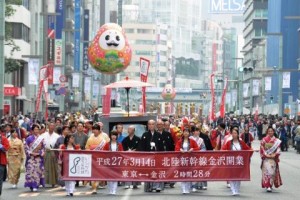The Hokuriku Shinkansen uses the new W7 and E7 train set, with a top speed of 260 km per hour, with power sockets at every seat, and compared to previous models has greater ability to break safely at high speed during earthquakes and has other enhanced safety features, as well as using a reduced sound pantograph, LED interior lighting and so on, all leading to the introduction of a more environmentally performing superior train.
Funding the building of the Hokuriku shinkansen
The Hokuriku Shinkansen is a ‘new trunk line’, the cost of which for the Nagano – Kanazawa line has come to 1 trillion 780 billion yen (£9.5 billion), of which the cost is borne by central government and the local authorities along the line, those being Nagano, Niigata, Toyama, and Ishikawa prefectures. Shinkansen or ‘new trunk line’ is a legal definition determined in the 1970 Nationwide Shinkansen Railway Development Law, and part of an overall scheme which commenced in the 1973 Japanese government improvement plan of five distinct high speed lines; the Hokkaido Shinkansen between Aomori and Sapporo, Tohoku Shinkansen (Morioka-Aomori), Hokuriku Shinkansen and Kyushu Shinaksen (Hakata-Kagoshima branch and Hakata-Nagasaki branch). The law for the building of these lines mandates that the financial burden be allocated 2:1 between the central government and local government.The Ishikawa Initiative
In Kanazawa, where the terminus station is located in Ishikawa prefecture, the Shinkansen opening PR strategy execution plan was formulated two years ago in 2013. In the plan major aspects included ‘maximising Ishikawa’s destination appeal’ and ‘effective PR in the Greater Tokyo area’, put into place to attract tourists as repeat visitors, encouraging them to visit two or three times, and to ensure that not only Kanazawa would benefit from tourism but other areas of the prefecture also, through maximizing the line opening for the first time as a celebration event.
Specific initiatives included holding events at Tokyo and Nihonbashi stations as well as others in the capital, the prefectural government carrying out a PR campaign in conjunction with Japan Rail, guidebooks published in a series to encourage repeat visits to Ishikawa (‘beginners Ishikawa’ ‘intermediate’ and ‘expert’ etc), and the creation of a ‘concierge’ style tourist information centre in Ishikawa station.Results of opening of the high speed rail line
The stated objective of opening the shinkansen line is to increase the number of visitors to Ishikawa. In comparing the numbers to before the line opened, the aim now is to double the tourist traffic from the capital area, as well as from overseas, and various initiatives are being carried out to reach these goals.
2013, 2,430,000 visitors from Greater Tokyo – target 5,000,000 visitors
2013, 240,000 visitors from overseas – target 500,000 visitors
In fact, since the Hokuriku line opening, many tourists are visiting. Since the opening date, starting with the major Japanese holiday of ‘Golden Week’ (from the end of April to the beginning of May), tour packages to the Hokuriku area from greater Tokyo sold five times up on the previous year, and for ‘Silver Week’ (September) four times the same period last year.
Further, other than affect an increase in tourists, the line has seen the relocation of industry, with the major Japanese non-ferrous metals manufacturer YKK Group moving more than 200 of its head office staff from Akihabara HQ in Tokyo to Kurobe City on the new shinkansen line in Toyama Prefecture. As well as this medical instruments and aeronautical parts manufacturer ‘Nikkiso’ has been operating a new factory in Kanazawa City since April of last year. In the future it plans to move its entire operations from Shizuoka Prefecture. The reasons for this being that the new area has increased access with the opening of the shinkansen, and also offers reduced impact from potential earthquakes and tsunamis in this part of Japan (historically, the Sea of Japan area is relatively at lower risk of major earthquake than other areas on the Japanese Pacific coast).
Future tasks
Throughout the Hokuriku region many have said that the opening of the shinkansen has fulfilled a dream long held for many years. However, the problem of ‘parallel lines’, where lines running along the shinkansen have been passed to the local authority from Japan Rail (a private sector company) but are now in a deficit, and with population outflows from the regions to the big cities, there are many problems which need a solution which local authorities along the line are now concentrating upon.




